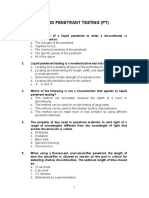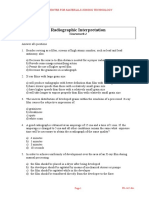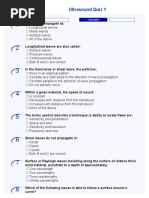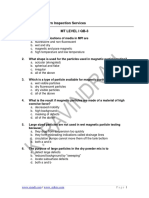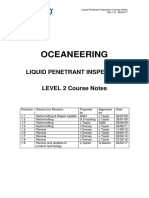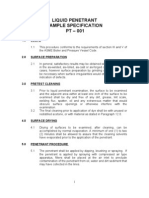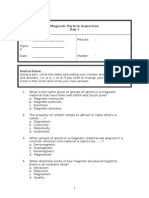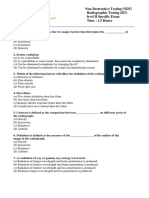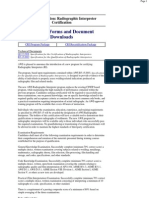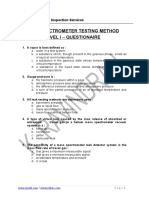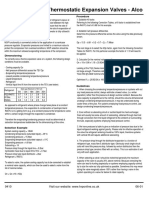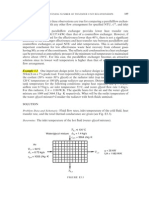PT CW 1
PT CW 1
Uploaded by
jasminneeCopyright:
Available Formats
PT CW 1
PT CW 1
Uploaded by
jasminneeOriginal Description:
Original Title
Copyright
Available Formats
Share this document
Did you find this document useful?
Is this content inappropriate?
Copyright:
Available Formats
PT CW 1
PT CW 1
Uploaded by
jasminneeCopyright:
Available Formats
WORLD CENTRE FOR MATERIALS JOINING TECHNOLOGY
Penetrant Testing
Coursework 1
Enter all answers on the answer sheet
1. The tendency of a liquid penetrant to enter a discontinuity is primarily due to:
a.
b.
c.
d.
Capillary forces
Specific gravity
Viscosity
Chemical inertness
2. The process by which a penetrant is drawn out of discontinuities by the developer is:
a.
b.
c.
d.
Capillary action
Suck back
Reverse capillary action
Gravitational attraction
3. A disadvantage of penetrant flaw detection is:
a.
b.
c.
d.
It can only detect surface breaking discontinuities
It cannot be used on fine cracks such as fatigue cracks
Parts cannot be re- tested
It cannot be used on non-ferrous materials
4. An advantage of penetrant flaw detection is:
a.
b.
c.
d.
It can be used on non-ferromagnetic materials
Fluorescent penetrant can be used for on-site testing of large parts
The temperature of the part need to be considered
Painted parts can be rapidly test
5. Which of the following is a type of penetrant?
a.
b.
c.
d.
Chemical etch penetrant
Non-aqueous penetrant
Post Emulsifiable penetrant
Non-ferrous penetrant
Page 1
PT-cw1 doc.
WORLD CENTRE FOR MATERIALS JOINING TECHNOLOGY
6. A dual sensitivity penetrant is:
a.
b.
A penetrant which can be used with only visible light
A penetrant which can be used both abnormally low and abnormally high
temperatures
c.
A penetrant that is suitable for wide, shallow discontinuities and for the cracks
such as fatigue cracks
d.
A penetrant to which replenisher can be added to change its sensitivity
7. Which of the following is not a type of developer?
a.
b.
c.
d.
Dry developer
Non-aqueous wet developer
Aqueous liquid developer
Liquid developer
8. A dry developer is generally applied to:
a.
b.
c.
d.
Viscosity
Surface tension
Wetting ability
No one single property determines if a material will or will not be a good penetrant
9. Excess water- washable fluorescent penetrant can be removed by:
a.
b.
c.
Hand wiping with a cloth moistened with solvent
Applying a lipophilic emulsifier
Spraying water until all traces of penetrant have been removed from the
surface
d.
10.
a.
b.
c.
d.
Drying in an oven at a temperature not greater than 85 C
Excess water- washable fluorescent penetrant can be removed by:
Hand wiping with a cloth moistened with solvent
Applying a lipophilic emulsifier
Spraying water until all traces of penetrant have been removed from the surface
Drying in an oven at a temperature not greater than 85 C
11. When fluorescent penetrants are used:
a. The inspector should allow five minutes before inspection to allow his eyes to become
accustomed to the lighting conditions
b. The quality of white light in the inspection booth should be limited to, typically 10 lux
c. Removal of excess penetrant is monitored under UV-light
d. All the above
Page 2
PT-cw1 doc.
WORLD CENTRE FOR MATERIALS JOINING TECHNOLOGY
12.
Which of the following is an advantage of the post-emulsifiable penetrant system
a.
b.
c.
d.
Excess penetrant is easier to remove from rough surfaces
Overall the process is cheaper
It is best for complex shape such as screw threads
It is highly sensitive on smooth surfaces
13. A disadvantage of dry powder developer is that:
a.
It is difficult to see whether the parts has been completely covered in
developer
b.
The part must be dried after application of the developer
c.
It can represent a potential safety hazard through inhalation
d.
It can only be used with colour contrast penetrants
14. A possible cause of non-relevant indications is:
a.
b.
c.
d.
Rivets
Contamination of dry powder developer with fluorescent penetrant
Failure to remove excess penetrant
Lint fibres on the test piece
15. Which of the following penetrant systems would be the most sensitive for the detection of
very fine defects:
a.
b.
c.
d.
Fluorescent water washable
Colour contrast water washable
Colour contrast solvent removable
Post emulsifiable fluorescent
16. Which of the following physical properties, more than any other, determines,
what makes a material at a good penetrant ?
a.
b.
c.
d.
Viscosity
Surface tension
Wetting ability
No one single property determines if a material will or will not be a good penetrant
17. When selecting a penetrant system which of the following factors would be considered:
a. Component surface finish
b. The sensitivity required
c. The compatibility of the penetrant with the material under inspection
Page 3
PT-cw1 doc.
WORLD CENTRE FOR MATERIALS JOINING TECHNOLOGY
d. All of the above would be considered
18. Which of the statements concerning liquid penetrant testing is correct?
a. Fluorescent penetrant will produce a red against white discontinuity indicates
b. Non-fluorescent penetrants require the use of black lights
c. Yellow-green fluorescent indications glow in UV-A light for easy viewing and
interpretation
d. Non-fluorescent indications glow in the dark for easy viewing and interpretation
19. The most widely accepted method of washing excessive water-washable penetrant from
the surface of a test specimen is:
a. By means of a wet rag
b. By means of a hose and special nozzle
c. Washing the part directly under water running from a tap
d. Immersing the part in water
20. Development time depends upon the:
a. Type of penetrant used
b. Type of developer used
c. Temperature of the material being tested
d. All of the above
21. The functions of the emulsifier in the post-emulsifiable penetrant method is to:
a. Drive penetrant into deep, tight cracks
b. React with surface penetrant to make the penetrant water washable
c. Add fluorescent dye or pigment to the penetrant
d. Provide a coating to which dry developer can adhere
22. Hydrophilic and lipophilic removers differ in that:
a. Hydrophilic removers are fluorescent whereas lipophilic removers are always colour
contrast
b. With hydrophilic removers, the application of the remover can be preceded by an
optional water wash. This is not the case with lipophilic removers
c. Lipophilic removers require a contact time at least twice as long as hydrophilic
removers
d. Hydrophilic removers are oil based whereas lipophilic removers are water
based
Page 4
PT-cw1 doc.
WORLD CENTRE FOR MATERIALS JOINING TECHNOLOGY
23. Capillary pressure would be greatest in which of the following:
a. A wide long crack
b. A long dirt filled crack
c. A fine clean crack
d. A wide shallow crack
24. Which of the following is not a basic inspection principle thats applied to all
penetrant methods?
a.
b.
c.
d.
The penetrant must enter the discontinuity in order to form an indication
Indications glow when illuminated with black lights
A longer penetration time is required for finer discontinuities
If the penetrant is washed out of the discontinuity, an indication will not formed
25. A good penetrant has:
a.
b.
c.
d.
Low volatility and high surface tension
Low volatility and low surface tension
High volatility and high surface tension
High volatility and low surface tension
26. Viscosity is a measure of:
a.
b.
c.
d.
How quickly the penetrant flows
How quickly the penetrant evaporates
The density of the penetrant compared to water
Wetting ability
27. Possible sources of non-relevant indications are:
a.
b.
c.
d.
Threads
Rivets
Splines
All of the above
28. An advantage of colour contrast penetrants over fluorescent penetrants is that:
a.
b.
c.
d.
They are more sensitive because the indications are easier to see
They do not require special lighting conditions
They are more suitable for smooth surfaces
They are less corrosive
Page 5
PT-cw1 doc.
WORLD CENTRE FOR MATERIALS JOINING TECHNOLOGY
29. Post-emulsifiable penetrants have the following advantages:
a. Excess penetrant is easier to remove from rough surfaces
b. Less penetrant is used than with water washable penetrants, and the process is
therefore cheaper
c. They can detect wide, shallow cracks
d. Parts are less liable to be over washed than with water-washable penetrants
30. Disadvantages of dry powder developers are that:
a.
b.
c.
d.
It is difficult to see whether the part has been completely covered in developer
The part must be dried after application of the developer
They can only be used with colour contrast penetrant
They should only be used with fluorescent penetrant
Page 6
PT-cw1 doc.
You might also like
- SAIW Welding and Fabrication Inspector Level 1 Course 2023Document3 pagesSAIW Welding and Fabrication Inspector Level 1 Course 2023Fred Plebie ColisNo ratings yet
- Latihan Soal PT NDTDocument3 pagesLatihan Soal PT NDTSendi Dwi OktaviandiNo ratings yet
- PT Specific 1Document4 pagesPT Specific 1vsnaiduqc100% (3)
- Handbook of RefractoryDocument331 pagesHandbook of RefractoryAamirMalikNo ratings yet
- PT 2ADocument4 pagesPT 2AjasminneeNo ratings yet
- Liquid Penetrant Quiz 1-1-2Document4 pagesLiquid Penetrant Quiz 1-1-2Salome sebatjanaNo ratings yet
- LPT Kavi Cha QBDocument47 pagesLPT Kavi Cha QBkingstonNo ratings yet
- Multi Choice Questions Dye Penetration Testing: This Column Is For Official Use OnlyDocument9 pagesMulti Choice Questions Dye Penetration Testing: This Column Is For Official Use OnlyAbdulmojeed AdisaNo ratings yet
- Liquid Penetrant Level 3 General ExamDocument10 pagesLiquid Penetrant Level 3 General ExambelalNo ratings yet
- Liquid Penetrant Testing (PT)Document6 pagesLiquid Penetrant Testing (PT)kingston100% (1)
- PT Level II G GULF-AILDocument8 pagesPT Level II G GULF-AILkingstonNo ratings yet
- Level - Ii Examination: General: Liquid Penetrant TestingDocument6 pagesLevel - Ii Examination: General: Liquid Penetrant TestingkingstonNo ratings yet
- Helier PT QBDocument22 pagesHelier PT QBkingston100% (2)
- PT CW 3Document6 pagesPT CW 3jasminneeNo ratings yet
- RI CW BDocument5 pagesRI CW Bmangalraj900No ratings yet
- Ultrasonic Testing Ut Q Bank A-1Document7 pagesUltrasonic Testing Ut Q Bank A-1kingstonNo ratings yet
- MT Level - I QB 5Document8 pagesMT Level - I QB 5kingstonNo ratings yet
- MT Level - I QB 4Document8 pagesMT Level - I QB 4kingstonNo ratings yet
- Ultrasonic Testing Ut Q Bank A-6Document8 pagesUltrasonic Testing Ut Q Bank A-6kingstonNo ratings yet
- Twi Training & Certification: You May Need To Read Ahead in The Notes To Answer Some of These QuestionsDocument6 pagesTwi Training & Certification: You May Need To Read Ahead in The Notes To Answer Some of These QuestionsZouhair BenmabroukNo ratings yet
- Level Ii Questions - RTDocument7 pagesLevel Ii Questions - RTViral ThankiNo ratings yet
- PT Final Exam Level-II (General)Document9 pagesPT Final Exam Level-II (General)RohitNo ratings yet
- Chapter 1Document10 pagesChapter 1kingstonNo ratings yet
- PT PracticalDocument40 pagesPT PracticalShyam Sundar GayenNo ratings yet
- Acoustic Emission Testing Method Level I Questions: Southern Inspection ServicesDocument5 pagesAcoustic Emission Testing Method Level I Questions: Southern Inspection Servicesprabhakaran.S100% (1)
- Level II QuestionDocument8 pagesLevel II QuestionSankar KrishnanNo ratings yet
- Ultrasound Quiz 1: First Name Last NameDocument7 pagesUltrasound Quiz 1: First Name Last NameahmedNo ratings yet
- Ultrasonic Testing Ut Q Bank A-5Document7 pagesUltrasonic Testing Ut Q Bank A-5kingstonNo ratings yet
- MT Level - I QB 3Document8 pagesMT Level - I QB 3kingstonNo ratings yet
- Rtfi Questions 6Document6 pagesRtfi Questions 6Azhar AhmadNo ratings yet
- Examination Guide For Initial Certification - AerospaceDocument35 pagesExamination Guide For Initial Certification - AerospacestandardlookingatNo ratings yet
- Rtfi Notes 1Document27 pagesRtfi Notes 1Ajith PayyanurNo ratings yet
- Non Destructive Testing and Evaluation (Liquid-Penetrant-Testing-Level-1 (Set-1) ) Solved MCQsDocument8 pagesNon Destructive Testing and Evaluation (Liquid-Penetrant-Testing-Level-1 (Set-1) ) Solved MCQsMusa AkbarNo ratings yet
- Radiography Testing Level I and IIDocument16 pagesRadiography Testing Level I and IIJoshnewfoundNo ratings yet
- 25 - VT Q&a 1-3Document38 pages25 - VT Q&a 1-3Ameem TariqNo ratings yet
- Acfm Underwater Inspection Probe CatalogueDocument13 pagesAcfm Underwater Inspection Probe CatalogueNam DoNo ratings yet
- Rusayl Institute: Ultrasonic Testing - Level Ii Ut Q Bank - 5Document16 pagesRusayl Institute: Ultrasonic Testing - Level Ii Ut Q Bank - 5kingston100% (2)
- LPI Course Notes Rev 1.9Document105 pagesLPI Course Notes Rev 1.9scandalthegood100% (1)
- RI CW 8Document8 pagesRI CW 8Saut Maruli Tua SamosirNo ratings yet
- LatihanDocument18 pagesLatihanAhmad Dulfi100% (1)
- Ultrasonic Testing Ut Q Bank A-2Document7 pagesUltrasonic Testing Ut Q Bank A-2kingstonNo ratings yet
- LPT Spe Level II Exam QBDocument10 pagesLPT Spe Level II Exam QBAruchamy SelvakumarNo ratings yet
- Materials and Processes Quiz 2Document7 pagesMaterials and Processes Quiz 2RuthNo ratings yet
- PT Theory English New 2014Document44 pagesPT Theory English New 2014CRISTIAN SILVIU IANUCNo ratings yet
- Chapter 4bDocument33 pagesChapter 4bAhmed shabanNo ratings yet
- Ut QuestionsDocument12 pagesUt Questionsmohamed100% (1)
- ANSWER: Dye Penetrant Test Explanation:: No Explanation Is Available For This Question!Document4 pagesANSWER: Dye Penetrant Test Explanation:: No Explanation Is Available For This Question!shyamkumar rakoti0% (1)
- Rusayl Institute Ultrasonic Testing - Level Ii Ut Q Bank - 4Document9 pagesRusayl Institute Ultrasonic Testing - Level Ii Ut Q Bank - 4kingstonNo ratings yet
- Magnetic Particle Inspection Day 1Document6 pagesMagnetic Particle Inspection Day 1Muhammad Hannan0% (1)
- Bubble Leak Testing Level I - Questionaire: Southern Inspection ServicesDocument8 pagesBubble Leak Testing Level I - Questionaire: Southern Inspection Servicesprabhakaran.SNo ratings yet
- RT - Specific ExamDocument3 pagesRT - Specific ExamAslaoui100% (1)
- Handbook 1 A29Document31 pagesHandbook 1 A29srgokuNo ratings yet
- AWS Radio Graphic InterpreterDocument5 pagesAWS Radio Graphic InterpreterShrey Gupta0% (1)
- Asnt RT Question BankDocument12 pagesAsnt RT Question Bankprabhakaran.SNo ratings yet
- Level I Questions Visual and Optical Testing MethodDocument30 pagesLevel I Questions Visual and Optical Testing MethodAndres TorresNo ratings yet
- PRR CalculationDocument4 pagesPRR CalculationnavitaNo ratings yet
- Magnetic Particle TestingDocument3 pagesMagnetic Particle TestingAnu AnoopNo ratings yet
- RI CW 9Document8 pagesRI CW 9Saut Maruli Tua SamosirNo ratings yet
- Challenges in Corrosion: Costs, Causes, Consequences, and ControlFrom EverandChallenges in Corrosion: Costs, Causes, Consequences, and ControlNo ratings yet
- PT Level 2 Welds CW 1Document4 pagesPT Level 2 Welds CW 1fadli heiNo ratings yet
- Rusayl Institute Liquid Penetrant Testing - Level Ii General QuestionaireDocument8 pagesRusayl Institute Liquid Penetrant Testing - Level Ii General QuestionairekingstonNo ratings yet
- 015 Emat Slofec TechniqueDocument9 pages015 Emat Slofec Techniquejasminnee100% (1)
- ACFMDocument77 pagesACFMjasminneeNo ratings yet
- Improve 20selection 20and 20sizing 20of 20storage 20tanksDocument6 pagesImprove 20selection 20and 20sizing 20of 20storage 20tanksjasminneeNo ratings yet
- API 571 SpreadsheetDocument38 pagesAPI 571 Spreadsheetjasminnee100% (4)
- Q PTDocument17 pagesQ PTEzhil Vendhan PalanisamyNo ratings yet
- Storing and Redrying Electrodes-Lincoln ElectricDocument3 pagesStoring and Redrying Electrodes-Lincoln ElectricjasminneeNo ratings yet
- The ABC's of Arc Welding and InspectionDocument93 pagesThe ABC's of Arc Welding and Inspectionmichaeldtalbott100% (1)
- Penetrant Testing: No Name / Position Company/Address Contact NosDocument2 pagesPenetrant Testing: No Name / Position Company/Address Contact NosjasminneeNo ratings yet
- 653 Section 06 ReviewDocument1 page653 Section 06 ReviewjasminneeNo ratings yet
- Twi Training & Certification (S.E. Asia) SDN - BHDDocument1 pageTwi Training & Certification (S.E. Asia) SDN - BHDjasminneeNo ratings yet
- API 653 PC 26feb05 Question BankDocument80 pagesAPI 653 PC 26feb05 Question Bankraobabar21100% (1)
- 510 PC OCT04 QAR Ex7 Closed PSJDocument6 pages510 PC OCT04 QAR Ex7 Closed PSJjasminneeNo ratings yet
- Api 510 Preparatory: Points To Recall - Day 5Document1 pageApi 510 Preparatory: Points To Recall - Day 5jasminneeNo ratings yet
- Api 510 Preparatory: Points To Recall - Day 1Document2 pagesApi 510 Preparatory: Points To Recall - Day 1jasminneeNo ratings yet
- API Standard 607: Fire Test For Soft-Seated Quarter-Turn ValvesDocument2 pagesAPI Standard 607: Fire Test For Soft-Seated Quarter-Turn ValvesjasminneeNo ratings yet
- Api 510 Preparatory: Points To Recall - Day 9Document4 pagesApi 510 Preparatory: Points To Recall - Day 9jasminneeNo ratings yet
- Api 510 Preparatory: Points To Recall - Day 3Document2 pagesApi 510 Preparatory: Points To Recall - Day 3jasminneeNo ratings yet
- Phosphoric Acid PDFDocument24 pagesPhosphoric Acid PDFabderrahimnNo ratings yet
- API Plan 99 - ENDocument3 pagesAPI Plan 99 - ENarunima04No ratings yet
- Cell MembraneDocument7 pagesCell MembraneZechariah NicholasNo ratings yet
- Alkyl Halide PDFDocument21 pagesAlkyl Halide PDFLitmus GodNo ratings yet
- Aerosol SprayDocument10 pagesAerosol SprayLuqman YusofNo ratings yet
- Artigo Porto Normal Mode Determination in CrystalsDocument38 pagesArtigo Porto Normal Mode Determination in CrystalsGelson RodriguesNo ratings yet
- Nitro Phosphate Report Rev.02Document21 pagesNitro Phosphate Report Rev.02Hassaan AhmadNo ratings yet
- FINAL SMAW-12-Quarter-3-module 3 PDFDocument20 pagesFINAL SMAW-12-Quarter-3-module 3 PDFRandy Sacatani100% (2)
- As 2243.4-1998 Safety in Laboratories Ionizing RadiationsDocument9 pagesAs 2243.4-1998 Safety in Laboratories Ionizing RadiationsSAI Global - APACNo ratings yet
- Answer 08 - Ithink - Soalan-B7Document3 pagesAnswer 08 - Ithink - Soalan-B7bookworm0% (1)
- Reactor Criticality Calculation - ExampleDocument2 pagesReactor Criticality Calculation - ExampleEllie AustinNo ratings yet
- MCB 407 Lecture FourDocument9 pagesMCB 407 Lecture FourPopoola OlakunleNo ratings yet
- The Delta RatioDocument2 pagesThe Delta RatioFirstglobalsupercopNo ratings yet
- Lab ManualDocument54 pagesLab ManualAyush GargNo ratings yet
- Thermostatic Expansion Valves - Alco: Operating Principles ProcedureDocument34 pagesThermostatic Expansion Valves - Alco: Operating Principles ProcedureMeher YoussfiNo ratings yet
- Rosmarinus - Farmakope MonografıDocument3 pagesRosmarinus - Farmakope Monografıeylul.irmak.tNo ratings yet
- Ejemplo DTML Crossflow PDFDocument2 pagesEjemplo DTML Crossflow PDFDaniel González Juárez100% (1)
- 1990 - A New Approach To Highefficiency Multibandgap Solar Cells PDFDocument5 pages1990 - A New Approach To Highefficiency Multibandgap Solar Cells PDFdarleydomingosNo ratings yet
- Relationships and Biodiversity Nysed Lab ReviewDocument14 pagesRelationships and Biodiversity Nysed Lab ReviewLivi EllerNo ratings yet
- HydrocarDocument3 pagesHydrocaralandino98No ratings yet
- Silica Sand in Jordan: The Solar Panels IndustryDocument4 pagesSilica Sand in Jordan: The Solar Panels IndustryMahmoud100% (1)
- Tyco - Sintakote - Design - Manual - Nov2004editionDocument140 pagesTyco - Sintakote - Design - Manual - Nov2004editionmottmac50% (2)
- Sds Poly Guard FDA 32 Us EngDocument10 pagesSds Poly Guard FDA 32 Us EngÆ José TonatiuNo ratings yet
- Stainless Steel - Grade 304 PDFDocument4 pagesStainless Steel - Grade 304 PDFRekta DEPNo ratings yet
- Pharmacology Ain Shams 123 - Compress 1Document552 pagesPharmacology Ain Shams 123 - Compress 1ahmed hoty100% (1)
- Infographics About CellsDocument6 pagesInfographics About CellsFern AndrèaNo ratings yet
- Es Bit BankDocument20 pagesEs Bit BankBabulu SahuNo ratings yet
- Jupeb CHM 003 M2Document4 pagesJupeb CHM 003 M2olatejuomole78No ratings yet
- Fire Technology and Arson InvestigationDocument22 pagesFire Technology and Arson Investigationmelbertgutzby vivas100% (1)
- Combustionandplasmasynthesisofhigh Tempraturematerials1989 PDFDocument774 pagesCombustionandplasmasynthesisofhigh Tempraturematerials1989 PDFDavid RomeroNo ratings yet









